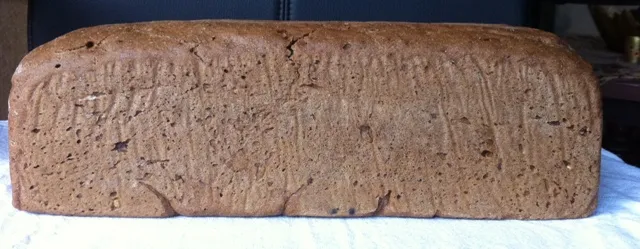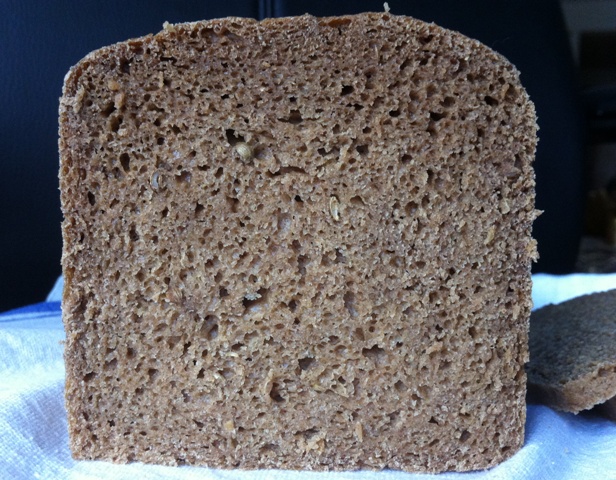
This is my second take on Andy’s (ananda) Borodinsky Rye. My Last attempt yielded a fine bread, but lacked volume to fill the pan, and was somewhat over-hydrated. This time, I've lined my Pullman pan with parchment paper, reduced the hydration of the rye dough, slid the pan cover on, and baked with steam throughout the 4.5 hours baking time at 100C (The oven was preheated to 250C).
I was surprised at the cake like softness that the crust had after adding a steady steam source during the long baking hours. The bread cooked through quite well, and the picture shown is 12 hours into cooling time. The crust color, however, suffered as my previous take of this bread was steam less and resulted in a dark caramelized crust that I love. Also, as can be seen from the loaf’s top surface, 1.7 Kg. dough wasn't quite enough to fill my 13” X 4” pan, so there should be at least 1.75 – 1.8 Kg. of dough in there. The remainder of the recipe dough was baked into mini silicon cup cake moulds.

I've sliced the bread this morning, as I couldn't wait for additional 12 hours. The bread was quite SOFT! moist, and very aromatic. I've chosen to exclude the coriander garnish to see how the flavor would be, and it was still very pleasant.
Now, i think i need to either eliminate steam during the whole 4 hours, or do so after only 2 . What do you think?
Khalid
- Mebake's Blog
- Log in or register to post comments
Khalid! I bake this bread "short", as many people do, but maybe the long slow steaming method is better, neverminding the crust? Either way it must be delicious!
Thanks, Mister TT
Umm.. I'll play around with baking times, and temperatures. I believe that these types of breads with so much scalded flour do need the lengthy bake, otherwise the crumb will be unpleasantly gummy and moist for extended period of time.
I'm sure Andy will have the best advice but many will remove the loaf from tin and finish naked in the oven to get more color on the crust. Alternativelan you could play with temps and let it bake hotter at the beginning and then decrease temp. Will obviously bake faster this way. Or remove the lid at some point during the end of the bake
Josh
I wouldn't place this soft bread on any surface naked, Josh, it'll squish the base. I'll try some of your suggestions.
Thanks!
Hi Khalid,
I usually bake the whole time with lid on. When it is 'done' I take the loaf out of the pan and bake it straight on the baking stone - 5 minutes to each long surface to caramelize the crust all around. (15 minutes extra bake time) Karin recommended this in one of her posts and I find it works nicely.
Take Care,
Janet
Thanks, Janet:) i'll try Karin's method.
Hi Khalid,
I don't like these loaves to have much of a crust to them personally. So I don't bake them out of their tins, or with the lid removed, for any part of the bake. If you want a darker crust then just turn up the heat of the oven a touch.
The loaf has a really nice shape to it; good job
All the best
Andy
A good suggestion, Andy. I may be used to german type rye breads, with heafty crusts.
Thanks For the recipe!
Getting closer to what you are looking for after each bake. I like a hearty, dark but soft crust too, The Maillard reaction needs temperatures over 120 C to really be effective in food caramelization processes as per this article. It's just science you can use to your advantage.
http://sciencegeist.net/the-maillard-reaction/
A shot cut out - "So, basically, the Maillard reaction can enhance the flavor of any food that contains proteins and sugars. While this description of any food containing protein and sugar, encompasses most of the things we eat, there are several types of food whose flavor profiles owe a lot to the Maillard reaction. Grilled meats. Roasted meats. Crusty bread. Dark beer. Roasted coffee. Chocolate. Toast. Cookies. Really, any food that you are cooking at temperatures above 250oF/120oC are going to have some Maillard components giving it color/texture/aroma.
This is why these kinds of breads usually start at 350 F or so with a falling temperature after a half an hour dropping 25 degrees or so every half an hour and finish at 250 F until the middle hits 205 F, You should get a darker crust that is still moist after the moisture redistributes itself. while resting.
Cooks Illustrated also did a piece on the Maillard reaction in cooking and their science guru thought temperatures over 300 F are the most useful to get this reaction to take place.
You are very close at any rate and the crumb looks fantastic.
Happy baking Khalid
Interesting information, DA. Armed with the new knowledge, and your baking suggestions, i think i'll be able to achieve the exemplary (for me) crust on this loaf.
Thanks for the valuable info, DA!
http://culinaryarts.about.com/od/glossary/g/maillard.htm
http://culinaryarts.about.com/od/glossary/g/caramelize.htm
Your loaf may be a little pale, but it looks good enough to eat in any case. I'm sure with the sage advice above you will easily remedy the pale crust and have this perfect in no time. It must taste great and your crumb looks very nice as it should for this style of bread.
Look forward to your next bake especially when you return to your last pastry classes.
Regards,
Ian